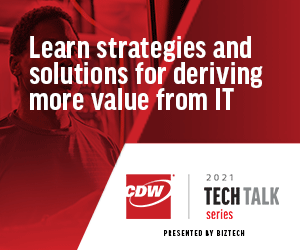BIZTECH: What are phases two and three?
Gupta: Phase two is about growing top-line revenue instead of just cutting costs. Revenue growth happens when you go into adjacent businesses and additional businesses that you never thought of, because the technology allows you to do that. Phase three is about completely reimagining your business, because the future of any industry will be totally different than what it was yesterday.
If you have that three-phase horizon in mind, then focusing on cutting costs for what you think will still be valuable in the future is perfectly reasonable.
BIZTECH: What are the big things companies should think about as they formulate digital strategies?
Gupta: It should be part of the fundamental strategy of the business. It’s no longer this separate part of the organization. It has to be a holistic story. There are a handful of things that should be looked at constantly by the senior executives of a company as to how they shape the industry and how they shape the company. It might be technology. It might be shifts in consumer behavior. There could be changes in regulations. There could be macroeconomic factors. There are always four or five broad trends that affect every organization.
Technology tends to touch on many different aspects of most of those trends: how consumers behave, how they get information, how they purchase things, etc., and that’s why you need to look at how the business is affected by technology, which is only an enabler to where the overall strategy is going.
WATCH: Learn how to build a digital strategy that works for your organization.
BIZTECH: How has the pandemic affected companies’ digital strategies?
Gupta: It has certainly accelerated things. Digital innovation is about changing the organization and how it operates, and I think there were two barriers to that change: one from the customer side, the other from the organization side. On the customer side, especially for older consumers, they’re used to doing things in a certain way — going to the store to shop, for example. So, it’s been much harder for them to get their heads around buying online. That has changed. My 80-plus-year-old father is now doing online shopping, and he enjoys it and he doesn’t see any way to go back.
The second change is within the organization. Take telehealth: Many healthcare organizations have been trying telehealth for a long time, but the challenge has been that patients felt the experience would not be the same, and physicians didn’t feel it would be the same level of care. Now, the dynamic has forced both the patient and they physician to use telehealth, and both of them are saying, “Hey, actually, it’s better.” The patient doesn’t have to sit in the doctor’s waiting room for half an hour, and the doctor doesn’t have to fill in paperwork while the patient is in the office.
Also, senior executives told me that they actually changed processes within their organizations, dramatically, that they couldn’t change before. Companies have suddenly become agile where they never could before, because they have to sell online. People are trying new things. If our dean at Harvard Business School had told us before the pandemic that we had to teach online, there would have been a revolt. Then, we all suddenly had to learn to teach online — and we did. Now we’re saying, “What can we learn from the online experience to bring into the offline environment?”













